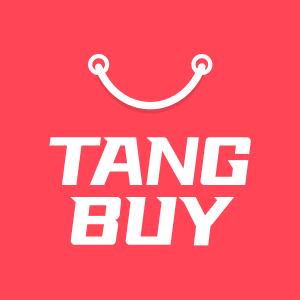What Is Dropshipping and How Does It Work? (2025)
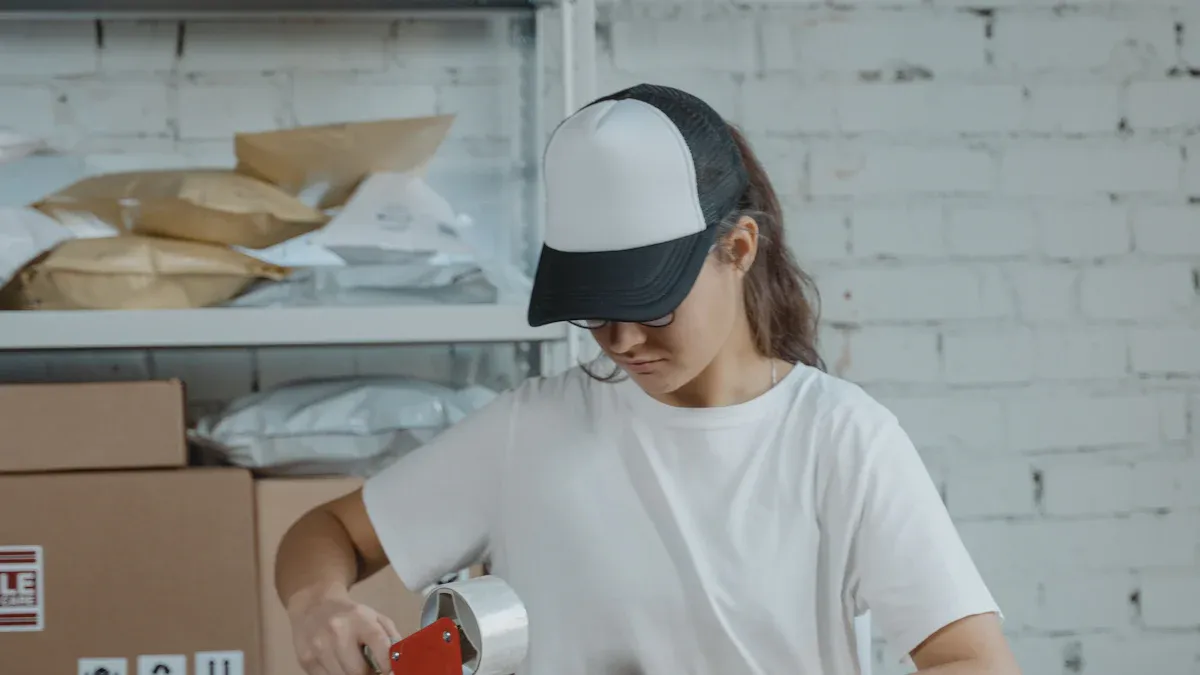
Dropshipping lets you sell things online without touching them. You make a store and choose what to sell. When someone buys something, your supplier sends it to the customer. In 2025, about one in three online stores use dropshipping. People like dropshipping because it is cheap to start. You do not need a warehouse. You can spend more time on ads or trying new products.
Key Takeaways
Dropshipping lets you sell things online without keeping or shipping products yourself. You act as a store owner and take care of your shop, ads, and helping customers. Suppliers do the packing and send out the orders. Starting dropshipping costs less than opening a regular store. You do not need to buy lots of products or pay for a warehouse. Picking a special type of product and good suppliers helps you get noticed and makes customers happy. You usually make less money on each sale, so you need strong ads and great customer help to do well. Talking quickly and clearly with suppliers stops problems and makes customers feel better. Dropshipping is good for people who like to learn, do marketing, and work from anywhere if they are patient. Careful planning, following the rules, and always testing new ideas help you build a dropshipping business that lasts.
Dropshipping Model
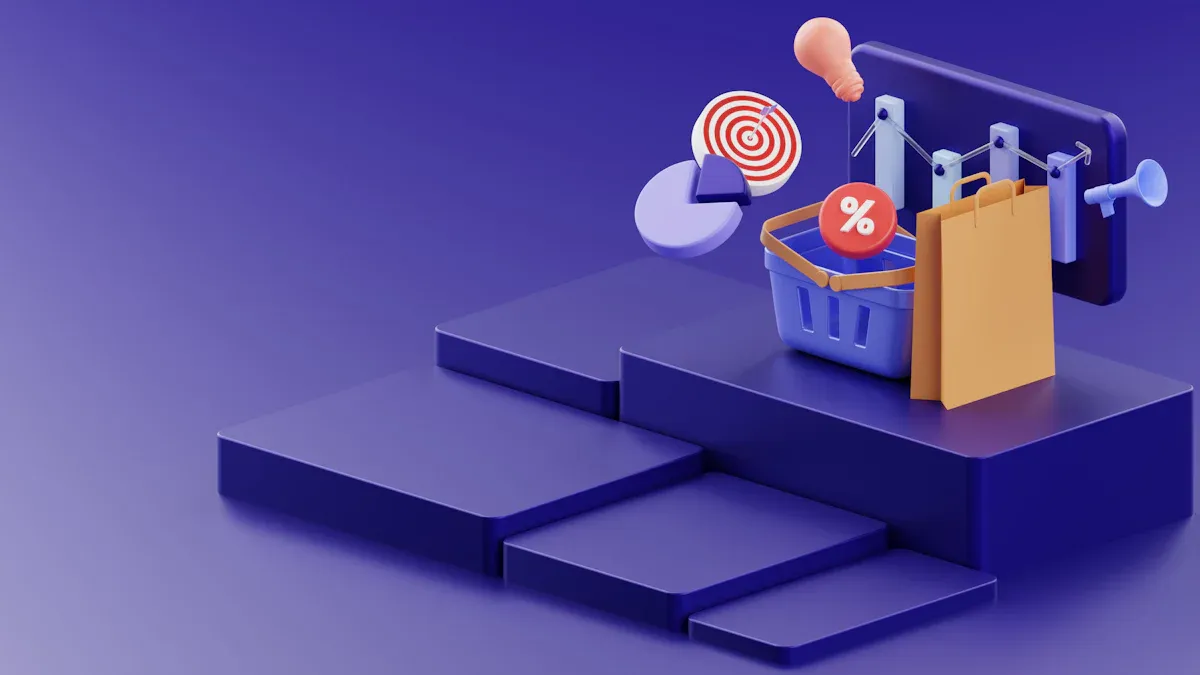
What Is Dropshipping
Dropshipping is a business model that lets you sell products online without ever touching them. You do not need to buy inventory in bulk or rent a warehouse. Your supplier stores the products, packs them, and ships them straight to your customer. You can run your store from anywhere, even your bedroom or a coffee shop. This model gives you the freedom to test new products and work with different suppliers. You can also adjust your product range quickly if you see a new trend.
Here are some key parts of the dropshipping model:
Low upfront investment because you do not buy stock ahead of time.
No need for warehousing or storage management.
Suppliers handle packaging and delivery, so you skip those costs.
You can work with several suppliers to offer more products.
You have the flexibility to manage your business from anywhere.
Tip: Dropshipping works best if you pick a focused niche and build strong relationships with reliable suppliers.
How It Works
Retailer, Supplier, Customer
You play the role of the retailer. You set up your online store, choose what to sell, and set your prices. Your main jobs include:
Creating and managing your storefront.
Marketing your products to attract customers.
Building relationships with suppliers.
Handling customer service and support.
You never have to store, pack, or ship products. Your supplier takes care of all that. The supplier stores the items, packs them when someone orders, and ships them directly to your customer. You focus on sales and keeping your customers happy.
The customer visits your store, places an order, and pays you. They never know the supplier’s name. You are their main contact for questions, returns, or problems.
Here’s a quick look at how these roles compare to traditional e-commerce:
Aspect | Dropshipping Model | Traditional E-commerce Model |
|---|---|---|
Inventory Management | You do not hold inventory. No storage or big upfront costs. | You buy and store inventory. You manage stock and warehousing. |
Shipping & Logistics | Supplier ships directly to your customer. Less work for you. | You pack and ship orders yourself. More control, but more work. |
Control over Inventory | Less control. You rely on your supplier’s stock and shipping. | More control. You know exactly what you have and how fast you can ship. |
Costs | Lower upfront costs. No inventory risk. Higher shipping costs if you use many suppliers. | Higher upfront costs. Risk of unsold stock. You may save on shipping by sending in bulk. |
Operational Complexity | Simple for you. Most work is marketing and customer service. | More complex. You handle inventory, packing, shipping, and returns. |
Profit Margins | Margins can be lower because suppliers charge for their service. | Margins can be higher if you buy in bulk and control costs. |
Risks | Supplier mistakes, stockouts, or shipping delays can hurt your business. | You risk having too much or too little stock, plus damage or theft. |
Order Fulfillment
The order process in dropshipping is simple and fast. Here’s how it usually works:
1. You partner with a supplier who stores and ships products. 2. You set up your online store and list the supplier’s products. 3. A customer places an order and pays you. 4. You send the order details to your supplier. Many stores do this automatically. 5. The supplier packs and ships the product straight to your customer. 6. The customer gets the product. You handle any questions or returns.
You never touch the product. Your job is to make sure the customer is happy and to keep in touch with your supplier. Good communication with your supplier is key. If there is a problem with shipping or returns, you need to solve it quickly to keep your customer satisfied.
Note: Even though you do not handle the product, you are still responsible for the customer’s experience. Make sure your supplier is reliable and ships on time.
Order Process
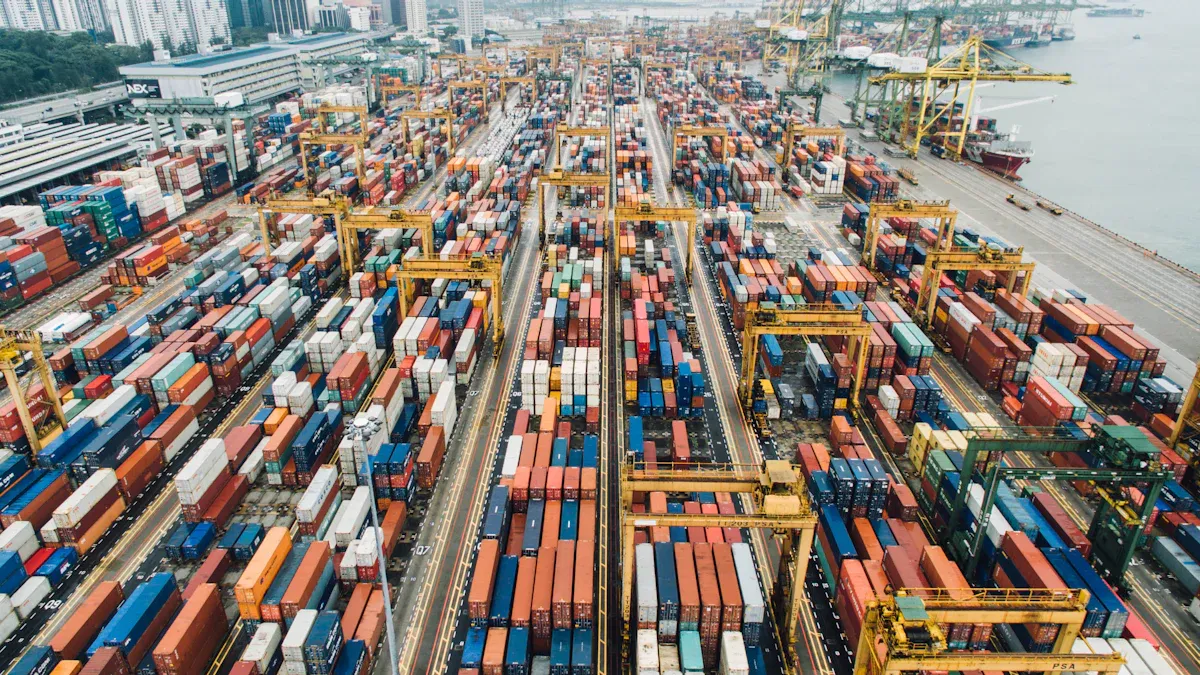
Steps Overview
Let’s see what happens when someone buys from your dropshipping store. You do not need to pack boxes or go to the post office. Here is how it usually works: 1. A customer visits your store and buys something. 2. You get a message and the customer pays you. 3. You send the order to your supplier. Many stores use apps to do this for you. 4. The supplier charges you, then picks, packs, and ships the item to your customer. They might use your store’s name on the package. 5. The supplier gives you a tracking number and a bill. 6. You give the tracking number to your customer and help them if they have questions.
Tip: Talking often with your supplier helps you avoid problems and keeps your customers happy.
Payment Flow
You may wonder how the money moves in dropshipping. Here is what usually happens: - Your customer pays you first when they order. Most people use credit cards or debit cards. Some use PayPal, Apple Pay, or Google Pay, especially on their phones. - You keep the extra money after paying your supplier. This is your profit. - You pay your supplier for the item, usually right after you get paid. Some suppliers let you pay for many orders at once, but most want payment for each order. - Payment tools like Shopify Payments, Stripe, or WooPayments help you take different kinds of payments. They also make sure payments are safe and quick.
Note: Giving more than one way to pay can help you get more sales. Some people like PayPal, while others want to use a card or pay with their phone.

Shipping

Shipping is very important in dropshipping. You never touch the product, but you need to know how long it takes to get to your customer. Shipping time depends on where your supplier is and which shipping method they use.
Here is a quick look at common shipping times:
Shipping Source | Typical Delivery Time | Notes |
|---|---|---|
China (Economy) | 15-30 days | Cheapest, but slowest |
China (ePacket) | 7-20 days | Faster, includes tracking |
China (Express: DHL/FedEx/UPS) | 3-7 days | Fastest, but expensive |
US Supplier | 2-7 days | Much faster, good for US customers |
Europe Supplier | 4-7 days | Faster for European customers |
Suppliers use different ways to ship, like ePacket, AliExpress Standard Shipping, DHL, or USPS. Cheaper shipping takes longer, but you can offer faster shipping for more money. If your supplier is in the same country as your customer, shipping can be as fast as two or three days.
Callout: Customers want fast shipping. If you use suppliers from China, tell your customers about possible delays. If you use local suppliers, you can promise faster delivery.
Dropshipping Pros & Cons
When you look at dropshipping, you will see both good and bad sides. Let’s break down the main benefits and drawbacks so you know what to expect.
Benefits
Low Startup Cost
You do not need a lot of money to start a dropshipping business. You skip buying inventory or renting a warehouse. Most of your costs go to your online store, marketing, and maybe a few apps. Here’s a quick look at common startup costs:
Cost Category | Estimated Cost Range (USD) |
|---|---|
Ecommerce Platform | $29 - $39 per month |
Domain Name | $10 - $15 per year |
Themes and Plugins | $20 - $150 |
Dropshipping Apps | $10 - $50 per month |
Marketing & Advertising | $200 - $500 per month |
Total (3 Months) | $950 - $2,000 |
You can see that dropshipping costs much less than traditional stores, which need money for stock and storage.
Minimal Risk
You only pay for products after you make a sale. This means you do not risk losing money on unsold items. If a product does not sell, you can remove it from your store without losing cash. You also avoid problems like overstock or wasted inventory.
Focus on Marketing
You spend most of your time on marketing and customer service. You do not have to pack boxes or manage a warehouse. This gives you more time to learn digital marketing, build your brand, and connect with customers. Many dropshippers use forums, guides, and online groups to get better at these skills.
Tip: Dropshipping lets you test new products quickly. If something does not work, you can swap it out with little effort.
Other benefits include:
Flexibility to work from anywhere 🌎
Easy to scale your business as you grow
Wide product selection by working with many suppliers
Access to global markets
Drawbacks
Lower Margins
Profit margins in dropshipping are usually lower than in other e-commerce models. You pay more per item because suppliers handle storage and shipping. Most dropshippers see margins between 10% and 30%. Take a look at this chart to compare:
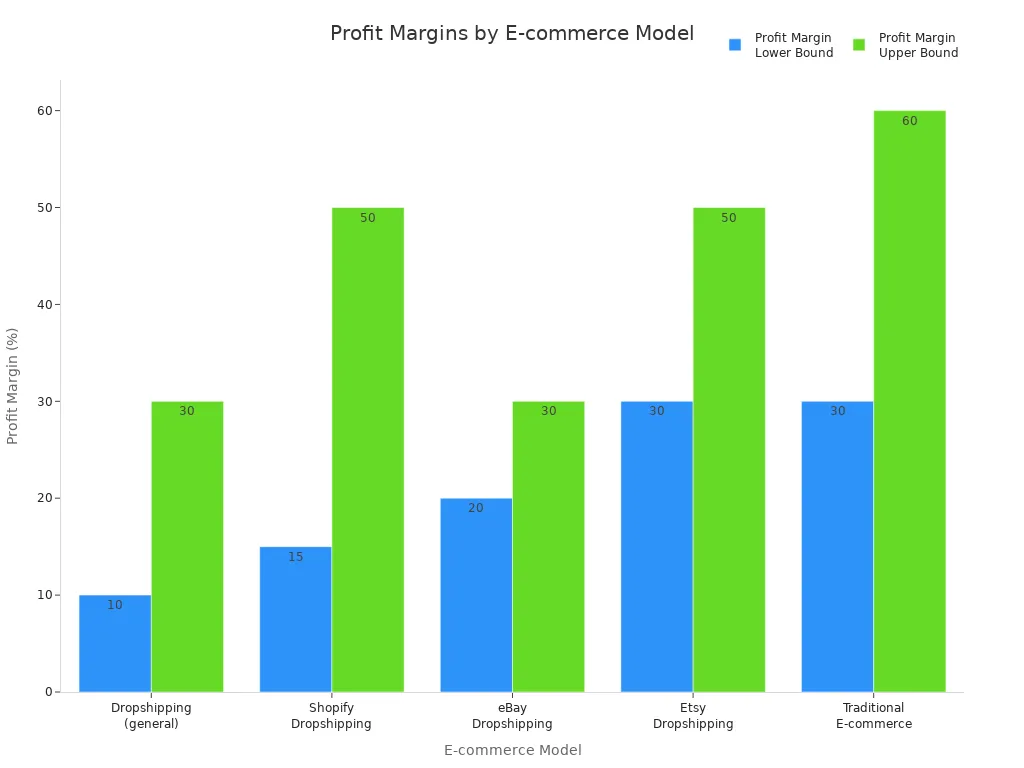
You may find it hard to spend much on ads or offer big discounts when your profits are slim.
Less Control
You do not control your supplier’s stock or how they pack and ship orders. If your supplier runs out of a product or ships late, your customer will blame you. Handling returns or complaints can be slow and tricky since you never see the product yourself.
Competition
Many people start dropshipping because it is easy to enter. This means you will face lots of sellers offering the same products. Price wars can break out, and you may need to spend more on ads to stand out. It can also be hard to build a unique brand when you sell the same items as others.
Note: Dropshipping works best if you focus on a niche and build strong relationships with reliable suppliers.

Is It Right for You
Who Should Try
Dropshipping works best for people who like to learn and try new things. If you enjoy finding cool products and sharing them with others, you might love this business. You do not need a lot of money to start, but you do need patience and a willingness to keep going, even when things get tough.
Here are some signs dropshipping could be a good fit for you:
You want to focus on a specific niche, like pet lovers or parents. Picking a niche helps you stand out and build a loyal group of customers.
You care about customer service and want to make shoppers happy.
You are ready to spend time on marketing, like running ads or working with influencers.
You can stick with it for at least a year, even if you do not see big profits right away.
You want to work from anywhere and like the idea of running an online business.
Tip: The most successful dropshippers do not just chase trends. They build a brand, offer great service, and work closely with reliable suppliers.
Who Should Avoid
Dropshipping is not for everyone. Some people jump in too fast and get frustrated when things do not go as planned. If you want quick money or do not like solving problems, you might want to look for something else.
Here are some common reasons people struggle with dropshipping:
Reason | Why It Causes Problems |
|---|---|
Not enough research | You might pick the wrong products or niche and lose money. |
Poor supplier choice | Bad suppliers can cause shipping delays or send low-quality products. |
High competition | Many stores sell the same items, making it hard to stand out. |
Weak customer service | If you ignore customers or handle returns badly, people will not come back. |
Impatience | Dropshipping takes time. If you give up too soon, you will not see results. |
If you do not enjoy helping customers or hate dealing with problems, dropshipping may not be right for you. You also need to be okay with some risk and ready to learn from mistakes.
Needed Skills
You do not need to be a tech genius to start dropshipping, but some skills will help you a lot. Here are the most important ones:
Skill | Why It Matters |
|---|---|
Sales & Marketing | You need to attract people to your store and convince them to buy. |
Customer Service | Happy customers come back and tell their friends. |
Time Management | You must juggle many tasks and stay organized. |
Product Research | Finding trending products keeps your store fresh and exciting. |
Creativity | Unique ideas help your store stand out from the crowd. |
Basic Tech Skills | You should know how to use a computer and manage your website. |
Note: The best dropshippers keep learning. They watch for new trends, test new products, and always look for ways to improve their store.
If you have these skills or want to learn them, dropshipping could be a great way for you to start your own business.

Getting Started
Niche Selection
Picking the right niche is the first big step in dropshipping. Your niche is the group of products you want to sell. A good niche helps you stand out and attract the right customers. You want something people want to buy, but not something everyone else is selling.
Here’s how you can choose a profitable niche in 2025:
Pick products that are durable, lightweight, and low-risk. These items have fewer returns and shipping problems.
Stay away from niches with legal or safety issues. Avoid products that need special certifications or face import restrictions.
Check the competition. Look for niches with fewer than 1,000 listings and not too many active stores. This helps you avoid crowded markets.
Read customer reviews. Find out what buyers like and what problems they have. This helps you spot gaps in the market.
Use tools like Google Trends and social media to see what’s popular and growing.
Make sure the products have good profit margins and steady demand.
Test your niche with a small trial before going all in.
Some popular and profitable niches right now include:
Home decor
Gaming accessories
Jewelry
Mobile phone accessories
Home office supplies
Kitchen tools
Pet supplies
Fitness and sports products
You should avoid niches like clothing (high returns), bulky furniture (expensive shipping), and health products (strict rules).
Tip: Focus on a niche you care about. It’s easier to market products you like and understand.

Supplier Choice
Your supplier is your business partner. A good supplier makes your life easier and keeps your customers happy. A bad one can ruin your store’s reputation. Here are the main things to look for:
Factor | Why It Matters |
|---|---|
Happy customers come back. Order samples to check quality before selling. | |
Supplier Reliability | You need orders shipped on time. Check reviews and ratings. |
Competitive Pricing | Low prices help you stay profitable. Watch for hidden fees. |
Shipping Times & Policies | Fast shipping keeps customers happy. Look for tracking and clear policies. |
Customer Support | Good support solves problems quickly. |
Warehouse Location | Closer warehouses mean faster, cheaper shipping. |
Technology & Efficiency | Suppliers with good software make order handling easier. |
Return Policies | Clear return rules protect your business. |
Avoiding Scams | Use trusted directories and avoid suppliers with vague info or upfront fees. |
You can find suppliers on trusted platforms like Spocket, SaleHoo, AliExpress, and CJdropshipping. These sites connect you with verified suppliers and offer tools to manage your orders.
Note: Work with more than one supplier if you can. This helps you offer more products and avoid problems if one supplier runs out.

Store Setup
Now you’re ready to build your store. This is where your business comes to life. Here’s a simple step-by-step guide:
Open a business bank account. Keep your business money separate from your personal money.
Set a budget. Decide how much you can spend on your store, ads, and tools.
Choose a business structure, like sole proprietorship or LLC. This affects your taxes and legal protection.
Pick an e-commerce platform. Shopify, WooCommerce, Wix, and Magento are popular choices for dropshipping.
Build your online store. Add your products, write clear descriptions, and upload good photos.
Set your prices. Make sure you cover all costs and still make a profit.
Plan for taxes. Learn about sales tax and other rules in your area.
Get a business license if needed.
Connect your store to your suppliers using apps or plugins.
Set up payment methods like credit cards, PayPal, or Apple Pay.
Tip: Start simple. You can always add more features and products as you grow.
Marketing
Marketing is where your dropshipping store comes to life. You can have the best products, but if no one sees them, you will not make sales. In 2025, smart marketing helps you stand out from the crowd and reach the right people.
You do not need a huge budget to start. Most new dropshipping stores spend between $500 and $1,000 each month on ads. You might also pay about $30 for SEO tools and $100 to $300 for content creation. Here’s a quick look at what you might spend:
Marketing Component | Estimated Cost Range |
|---|---|
Initial Advertising Budget | $500 to $1,000 per month |
SEO Tools | About $30 per month |
Content Creation (optional) | $100 to $300 |
Tip: Start small. Pick one or two platforms first. See what works before you spend more.
So, how do you get people to visit your store and buy? Here are the top marketing strategies for dropshipping in 2025:
Social Media Marketing: Use Instagram, Facebook, and TikTok to show off your products. Post photos, stories, and videos. People love to see real-life uses and happy customers.
Facebook Ads: Run ads that target your ideal customer. You can choose age, interests, and even where they live. This helps you reach people who are most likely to buy.
SEO (Search Engine Optimization): Make your website easy to find on Google. Use keywords in your product titles and descriptions. Write blog posts about your niche. This brings in free traffic over time.
Email Marketing: Collect emails from visitors. Send them updates, special offers, and product tips. Segment your list so each person gets messages that fit their interests.
Video Marketing: Create short videos showing how your products work. Post them on Instagram, YouTube, or TikTok. Videos grab attention and help people trust your brand.
Customer Reviews and Testimonials: Ask buyers to leave reviews. Show these on your website. Good reviews build trust and help new shoppers feel safe buying from you.
Retargeting: Sometimes people visit your store but do not buy. Use retargeting ads to remind them about your products. This can turn window shoppers into buyers.
You can also try influencer partnerships. Find people on social media who match your brand. Ask them to share your products with their followers. This can bring in lots of new customers.
Note: Omnichannel marketing works best. This means you reach customers in many places—social media, email, search engines, and even text messages. The more places people see your brand, the more likely they are to buy.
Do not forget about your website. Make it easy to use on phones. Keep checkout simple. Add customer reviews and clear product photos. Fast websites help people stay longer and buy more.
If you join online groups or forums about your niche, you can answer questions and share tips. This builds trust and brings people to your store.
Marketing takes time and testing. Try different ideas. Track what works. Change your plan as you learn. With patience and smart marketing, you can grow your dropshipping business in 2025.
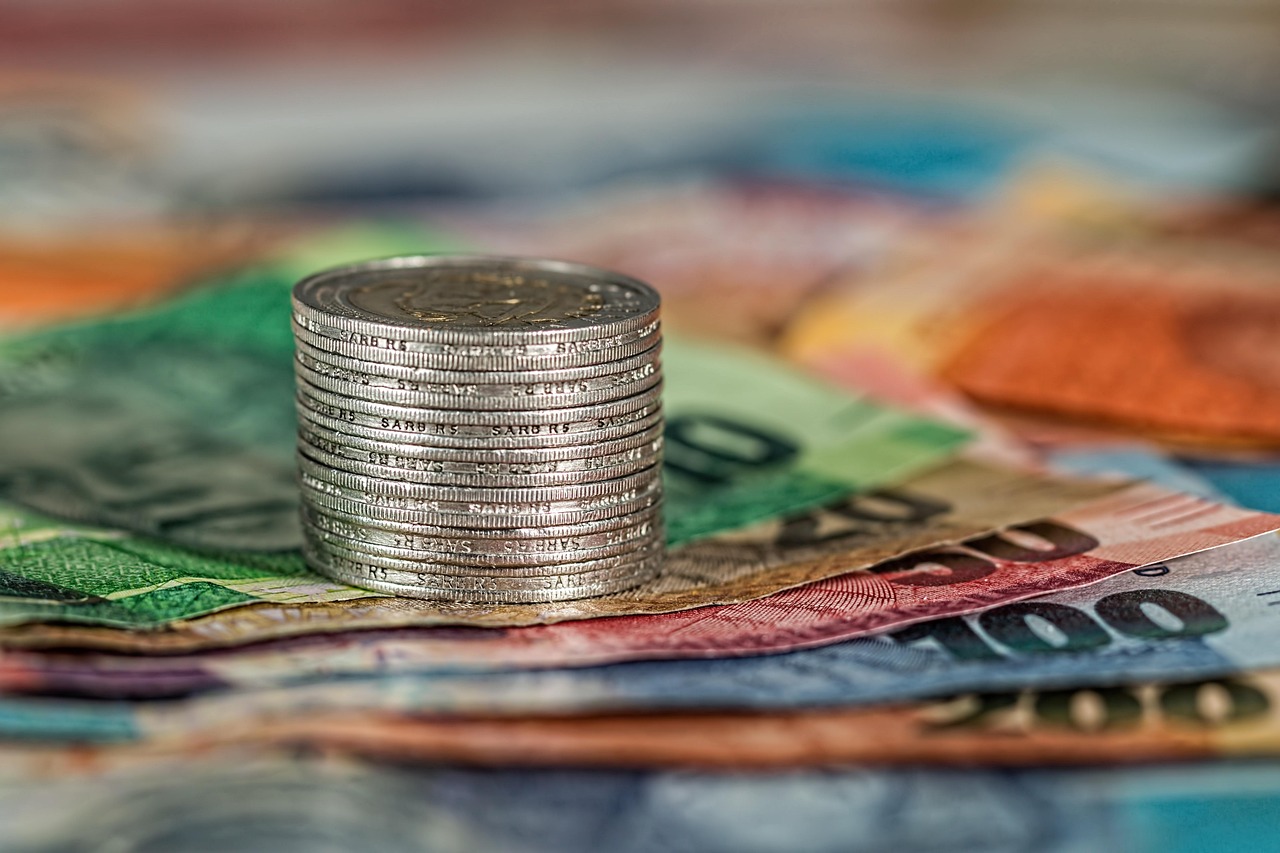
Costs & Profit
Startup Costs
You might think dropshipping is free to start, but you will need some money to get going. Most people spend between $500 and $2,000 to launch a small store. If you want a bigger or fancier store, costs can go up to $10,000 or more. Here’s a table to help you see where your money goes:
Expense Type | Cost Range (USD) | Notes |
|---|---|---|
Web Design & Theme | $500 – $5,000 | One-time, can use free themes |
Legal & Consultancy Fees | $500 – $2,000 | One-time, for business setup |
Initial Marketing | $500 – $2,000 | One-time, ads and promotions |
Licenses/Permits | $0 – $300 | One-time, depends on your location |
Domain Name | $10 – $20/year | Recurring, yearly |
E-commerce Platform | $29 – $299/month | Recurring, monthly |
Website Hosting | $10 – $300/month | Recurring, monthly |
Dropshipping Supplier Fees | $20 – $100/month | Recurring, monthly |
$0 – $50/month | Recurring, monthly | |
Email Marketing Software | $20 – $200/month | Recurring, monthly |
Marketing & Advertising | $200 – $2,000/month | Recurring, monthly |
You can start with less, but it’s smart to have a little extra for surprises. Some people get started for as low as $132, but a safer budget is around $500. Remember, you will have monthly costs to keep your store running.
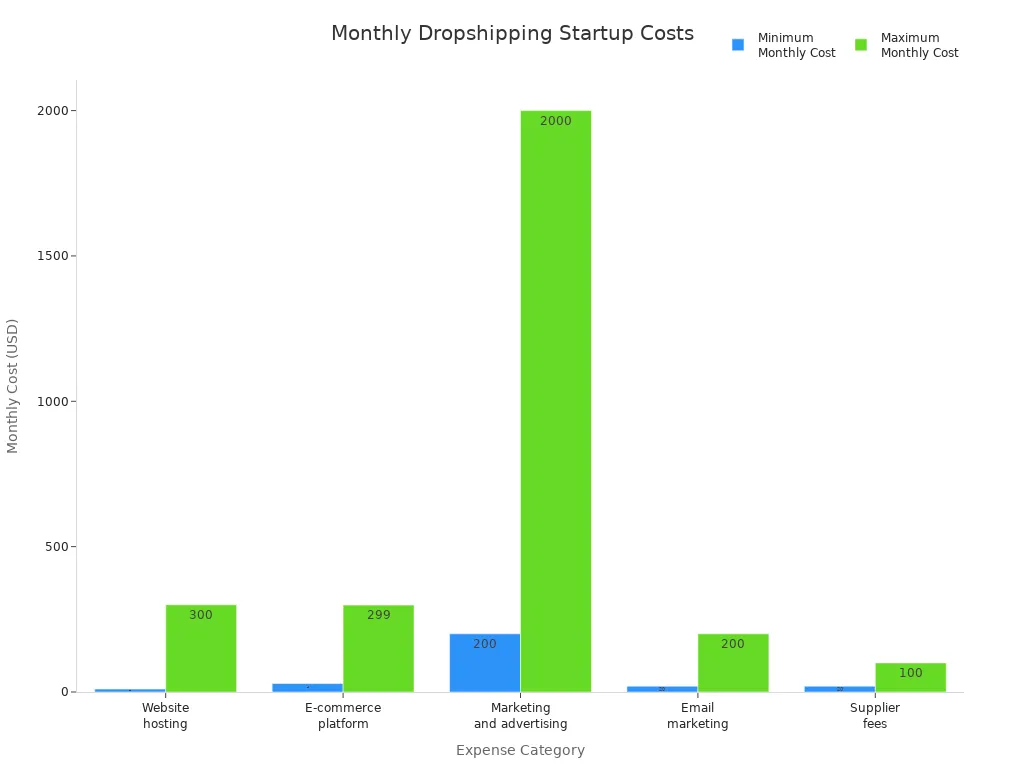
Tip: Plan for both one-time and monthly costs. This helps you avoid running out of money before your store takes off.
Profit Potential
You probably want to know how much money you can make. Most dropshipping stores in 2025 see profit margins between 10% and 30%. Your margin depends on what you sell, your supplier’s prices, and how much you spend on ads.
High-ticket items can bring bigger profits, but you may need to spend more on marketing.
Products like clothes or electronics often have more returns, which can lower your profit.
Shipping costs and tariffs can also eat into your earnings.
Here’s a simple example:
If you sell $50,000 worth of products and your cost of goods is $35,000, your gross profit margin is 30%. But after you pay for ads, platform fees, and returns (let’s say $4,000), your net profit is $11,000.
You should aim for at least a 10% margin to keep your business healthy. Many beginners try for 20%. Always track your expenses so you know your real profit.
Note: Dropshipping is not a get-rich-quick scheme. You need to work hard, test products, and keep learning to grow your profits.
Legal Issues
Running a dropshipping business means you need to follow the law. Here are the main things you should watch out for:
Get the right business licenses or permits for your area.
Collect and pay sales tax, income tax, and sometimes VAT or customs duties if you sell internationally.
Follow rules for shipping, customs, and import/export if you ship across borders.
Protect your customers’ data and follow privacy laws.
Make sure your products do not break copyright, trademark, or patent laws.
Write clear return and refund policies to follow consumer protection laws.
Check if your products need special permits (like food or health items).
Do not sell to banned countries or people under sanctions.
Make legal agreements with your suppliers about who is responsible for shipping and product problems.
Keep good records of your sales and taxes.
Tip: Laws can change from country to country. Talk to a tax pro or lawyer who knows e-commerce. This helps you avoid big mistakes and fines.
You will need to stay organized and keep learning about legal rules as your business grows. This keeps your store safe and helps you build trust with your customers.
You now know what this business model is, how it works, and what you need to get started. Think about your goals and resources before you jump in. If you want to learn more, check out online guides or join e-commerce groups.
Success takes time and patience. Stay curious, keep testing, and do not give up when things get tough.

FAQ
What do I need to start a dropshipping store?
You need a computer, internet, a business idea, a store platform (like Shopify), and a supplier. You also need a way to accept payments. Most people start with a small budget and grow from there.
Can I run a dropshipping business from anywhere?
Yes! You can work from home, a coffee shop, or even while traveling. You only need internet access to manage your store and talk to customers or suppliers.
How do I find good products to sell?
Look for trending items using tools like Google Trends or TikTok. Read customer reviews and check what people buy often. Try to pick products you like or know about. Testing different products helps you find winners.
Do I need to handle shipping or returns?
No, your supplier ships orders for you. If a customer wants to return something, you talk to your supplier and help the customer with the process. You still need to give good customer service.
How much money can I make with dropshipping?
Most stores see profit margins between 10% and 30%. Your earnings depend on what you sell and how well you market your store. Some people make a few hundred dollars a month, while others earn much more.
Is dropshipping legal?
Yes, dropshipping is legal in most countries. You must follow business laws, pay taxes, and avoid selling banned or fake products. Always check the rules in your country before you start.
What if my supplier makes a mistake?
Mistakes can happen. If your supplier ships the wrong item or ships late, you need to fix the problem for your customer. Good communication with your supplier helps you solve issues quickly.

TangBuy: A Smarter Way to Dropship in 2025
If you're looking to stay competitive with dropshipping in 2025, speed and trend-awareness are key. TangBuy helps you stay ahead with real-time product trends, fast fulfilment, and factory-direct sourcing. With over 1 million ready-to-ship items, 24-hour order processing, and seamless Shopify integration, TangBuy makes it easier to test, scale, and succeed in today's fast-moving eCommerce landscape.
See Also
Understanding The Real Expenses Of Dropshipping In 2025
Complete Stepwise Plan To Start Dropshipping In 2025
Profitable Dropshipping Concepts To Earn Income In 2025
Easy Methods To Profit From eBay Dropshipping In 2025
Comparing Dropshipping And Amazon FBA For Higher Earnings 2025
